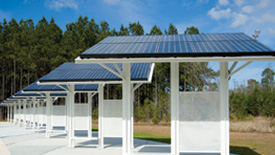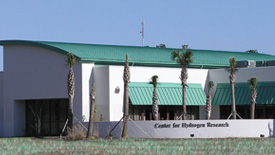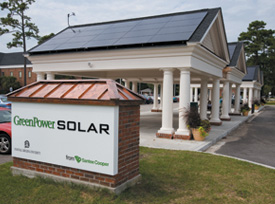Solar Energy is no different than the energy created by electric utilities; only the environmentally-friendly process by which it is created is different.
The sun is essentially a huge power plant sending out waves of energy made up of small particles called photons. These photons enter the Earth’s atmosphere and are responsible for the heat and light that we receive from the sun. When these photons hit the surface of a photovoltaic cell (The large panels on houses, calculators or in solar energy farms), they help produce an electrical current.
There are currently 10 Green Power Solar demonstration projects in the state.
Grand Strand Solar Station
Location: Myrtle Beach, S.C.
Capacity: 311 kilowatts
Commercial Operation: April 2011
The Grand Strand Solar Station has a rated capacity of 311 kilowatts generated by 1,325 solar panels. The panels are mounted on rooftops and an adjacent field at Santee Cooper’s warehouse facilities in Myrtle Beach. There is a pull-off area and signage to accommodate vistors who want to learn more about solar power. The panels are designed to withstand winds of 130 mph and 1-inch hail at 52 mph.
Coastal Carolina University
Location: Conway, S.C.
Capacity: 16 kilowatts
Commercial Operation: July 2006
In 2006, the first solar Green Power site was dedicated in South Carolina at Coastal Carolina University. Photovoltaic modules were installed on four open-air structures, each measuring 27 feet by 22 feet. The structures are used as a bus stop shelter and for other campus events. Also located at the site are special metering equipment that enables viewers to see how much electricity is being produced at any moment. A nearby educational Web-based exhibit includes access to site performance data and other renewable energy information.
Center for Hydrogen Rearch (CHR)
Location: Aiken, S.C.
Capacity: 20 kilowatts
Commercial Operation: May 2009
The photovoltaic array is installed in two locations, on the roof of the CHR connected to the Education, Training and Development Laboratory, and in a ground-level solar park that will give access to school groups, and other interested parties. The roof hosts a 14 kilowatt set of panels, and the solar park holds the remaining 6 killowatt set.
Technical College of the Lowcountry
Location: Bluffton, S.C.
Capacity: 20 kilowatts
Commercial Operation: February 2010
In early 2010, Santee Cooper, Palmetto Electric Cooperative and the Technical College of the Lowcountry (TCL) dedicated a 20-kilowatt solar array at TCL’s New River Campus. The solar project includes a series of nine canopies, each covered with 10 solar panels and sheltering a bench, adding another level of functionality to the installation. The electricity generated by the panels are metered and supplied to the grid through Palmetto Electric Cooperative’s distribution system.
Center for Advanced Technical Studies (CATS)
Location: Chapin, S.C.
Capacity: 4 kilowatts
Commercial Operation: December 2016
The solar project is unique such that there are two separate arrays comprised of one fixed-tilt and one dual-axis tracking array, each at 2 kilowatts of capacity. The solar array is also incorporated into the school's curriculum where students enrolled in the Clean Energy Technology Class learn about solar energy and study the differences between the arrays.
York Electric Cooperative
Location: Fort Mill, S.C.
Capacity: 8 kilowatts
Commercial Operation: March 2014
The solar project is located outside the York Electric Cooperative Fort Mill office and consists of four pole-mounted solar arrays at 2 kilowatts each. All the energy produced by the array is sent to the grid and consumed by customers.
Trident Technical College - Berkeley Campus
Location: Moncks Corner, S.C.
Capacity: 4 kilowatts
Commercial Operation: March 2017
Trident Technical College – Berkeley Campus 4 kW solar structure provides a shaded and water-tight seating area with a charging station for phones and computers for students just outside the Trident Technical College in Moncks Corner, S.C. The structure design was engineered and produced by Florian Solar of Georgetown, S.C.
Bell Bay Solar Farm
Location: Conway, S.C.
Capacity: 1.6 MWac
Commercial Operation: March 2018
The Bell Bay Solar Farm is unique in that it is oriented to the southwest and tilted at an optimal angle in order to produce a maximum amount of energy for summer air-conditioning needs. The property is adjacent to major transmission and distribution substations. It is located on Highway 701, south of Conway.
Jamison Solar Farm
Location: Orangeburg, S.C.
Capacity: 1.2 MWac
Commercial Operation: April 2019
The Jamison Solar Farm is located on property owned by Tri-County Electric Cooperative (TCEC) and is part of an industrial park being developed by TCEC. It is visible from I-26, north of the Highway 601 interchange (exit 145). The site cover has been planted in native plants, as a demonstration of the South Carolina Solar Habitat Act, to provide an attractive and low-maintenance project that will improve the soil.
Runway Solar Farm
Location: Myrtle Beach, S.C.
Capacity: 2 MWac
Commercial Operation: December 2019
Runway Solar Farm is located on Myrtle Beach airport property at 2630 King’s Highway. The site was formerly a landfill, so no penetrations of the surface were allowed. It was built using concrete ballasts that are constructed to hold the modules in place even in hurricane winds up to 132 mph. Special studies were done to ensure that there is no glint or glare to the pilots or control tower personnel. Horry County and the Myrtle Beach International Airport helped make this project a reality.
Green Power Solar Schools - (Click here for more information on solar schools)
Through the Green Power Solar Schools program, Santee Cooper and the Electric Cooperatives of South Carolina partner to install 2 kilowatt displays at schools statewide. Students at these schools learn about renewable energy through a state approved curriculum. We're educating tomorrow's leaders about the opportunities and limitations of solar power.
We're educating tomorrow's leaders about the opportunities and limitations of solar power.




